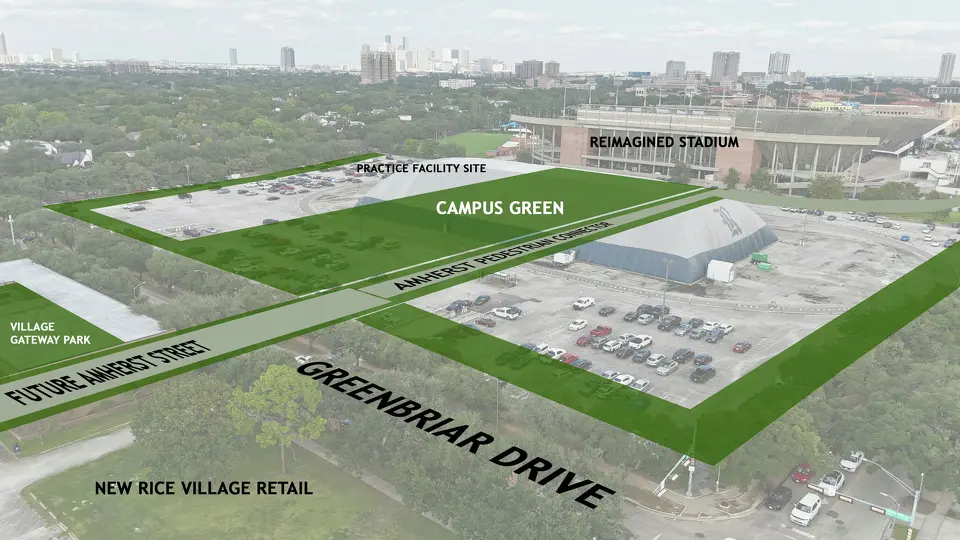Rice University is launching a massive $120 million project to renovate its historic Rice Stadium and to connect the west side of campus to Rice Village with a new pedestrian walkway.
The so-called “Gateway Project” is expected to transform unused property already owned by Rice, creating a park-like space for fans at the stadium plus easier access between the oak-lined campus and the Rice-owned shopping area. The project will also open up several extra blocks for retail and green space at Rice Village.
The stadium renovation will start after the 2026 season, and the Owls should be able to play most home games through the construction in 2027. The project is expected to stretch into 2028.
“This is a generational investment in the growth and vitality of Rice University,” said Robert T. Ladd, chairman of the Rice Board of Trustees. “By physically linking our university to one of Houston’s most dynamic neighborhoods and modernizing a cornerstone of our athletics district, we are honoring Rice’s legacy while paving the way for future growth, connectivity and impact.”
For more than a decade, university leaders and boosters have debated what to do with the stadium — a landmark that former athletic director Joe Karlgaard once called an “albatross.” It is one of Houston’s most storied event spaces, having hosted Super Bowl VIII and President John F. Kennedy’s historic “We choose to go to the moon” speech in 1962.
But Rice has struggled to fill the stadium consistently, and at times, university officials have battled a perception of neglecting Rice’s athletics program. The university has created more energy around its sports teams lately, especially with Rice joining the American Athletic Conference in 2023. Recent improvements to Rice Stadium added the $33 million Brian Patterson Sports Performance Center in the south end zone, cutting capacity from 70,000 to 47,000 seats.
While the revamp of Rice Stadium will keep elements of its 1950 design on the east side and in the lower bowl, other changes will modernize the stadium, keeping up with trends across college athletics. Rice officials hope to host more non-football events at the stadium, while game-time capacity will reduce to 30,000 seats — meaning fans can expect a louder, more intimate crowd as they cheer on the Owls.
[…]
In addition to the stadium facelift, Rice will develop a new corridor to link campus with the pedestrian-friendly Rice Village. The corridor will extend Amherst Avenue two blocks east from Morningside Drive, through Chaucer Drive, until it reaches campus with a new entrance on Greenbriar Drive. It’s mostly an unused parking lot currently.
The new road will expand the physical footprint of Rice Village. Officials with Rice Real Estate Co. say they hope to attract retail, multifamily housing and a grocery store along the street, which will also be walkable for students. Plans call for a public lawn for performances and community events.
At Greenbriar, the road will turn into a pedestrian-only walkway with trees, lighting and green space, taking students from the edge of Rice Village to Rice Stadium. Crews will install new drainage, sewage and water lines as part of the project.
“Rice Village has always been an important part of Rice,” University President Reginald DesRoches said. “Connecting it more to the Village is going to be better for Rice and certainly better for the surrounding community. We welcome them to come and give their thoughts and be part of this process.”
It’s a long story with a lot of detail and a bunch of conceptual photos of what the finished product should look like, so go read the rest. My first reaction was “But where will they have Beer Bike”, because that greenway is going right through where the bike track is now. I’m sure someone has thought of that. My second reaction is that this is a huge change for Rice, not just struBiutcturally but philosophically. When I arrived as a grad student in 1988, Rice divided the world into “inside the hedges” – i.e., on campus – and “outside the hedges”, literally everywhere else. This is bridging the two in a way that I’m sure would have been foreign to earlier generations of Owls.
And I think that’s great, for a couple of reasons. One, as noted it looks really appealing, and should be a terrific amenity for the Rice community and also for its close neighbors to the west. Two, it sure seems like a good time for universities everywhere to better integrate themselves with their surroundings, to make themselves a part of their larger communities and give them a sense that these oddball little places have something for them as well. When in “us versus them” times, investing in being part of a larger “us” makes sense.
The benefit for people who attend Rice football games is obvious, but that’s a small population even in the best times – there’s only a half dozen or so games a year. But if the stadium and now the attached Greenway space can attract more events, big and not so big, that’s a whole lot more people that will enjoy it. I can imagine this even working out well for the Shepherd School and its performance calendar – that building is on the east side of the stadium, which if connected via a pedestrian path from the new Gateway area would make it accessible to people in the Rice Village who don’t mind a bit of a hike to see some high-end music. That might be beyond their scope, but my point is that with a bit more vision there’s a lot of possibility here. I look forward to seeing what it turns into. CultureMap has more.

